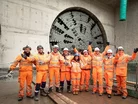Balfour Beatty VINCI celebrates milestone TBM breakthrough

Launched in November last year, the 2,000 tonne Tunnel boring machine (TBM) has completed its one-mile second bore, making it the first complete twin-bore tunnel on the HS2 project.
After completing the first bore of the tunnel in July 2022, the 125 metres long TBM was dismantled and returned to the north portal where it was reassembled ready to start its second journey.
Members of the Balfour Beatty VINCI tunnelling team were on site to witness the moment the huge cutterhead broke through the reception box headwall. This marks the culmination of a three-year operation, from site set-up and TBM assembly, the first TBM drive and breakthrough, and now completing the second breakthrough.
Huw Merriman, Rail Minister said: "This is yet another ground-breaking moment in the delivery of HS2 and the transformation of journeys and communities across Britain.
“With the help of Tunnel Boring Machine Dorothy, these tunnels are paving the way for HS2 trains while preserving ancient woodland on the land above. These tunnels help ensure that we deliver this transformative project while protecting the natural environment.”
David Speight, HS2 Ltd’s Delivery Director for Main Works Civils on Phase One said: “I’d like to congratulate the 400-strong Balfour Beatty VINCI tunnelling team for achieving this fantastic milestone on the HS2 project. This is a key moment in HS2’s operation in the Midlands, which is now reaching peak momentum with over 400 businesses in the region already winning work, and 9,000 jobs supported.
“We’re looking forward to celebrating more milestones as work gathers pace on key structures such as the Delta Junction viaducts, Birmingham Curzon Street station, Interchange station and Washwood Heath Depot, creating more opportunities for local businesses and people.”
Michael Dyke, Chief Executive Officer for Balfour Beatty HS2 Major Projects, added: “Successfully completing the first twin-bore tunnel on Britain’s new, highspeed railway is yet another demonstration of how works continue to progress at pace across the project. It’s a huge achievement, not only for Balfour Beatty VINCI, but for everyone connected with HS2.
“Watching Dorothy break through her second one-mile journey today was only possible thanks to months of hard work and dedication from our 400-strong project team, who deserve a special mention for safely delivering this incredible feat of engineering.”
Tunnel Surveyor Apprentice Jake Flood from Walsall, who joined Balfour Beatty VINCI's tunnelling team last year was on site to mark the launch of the TBM back in November, said: “I witnessed the launch of Dorothy just after I started my apprenticeship last year. It was an incredible moment, and I am thankful that I have had the opportunity to support the tunnelling team over the past four months.
“It’s very special to be invited to watch the breakthrough alongside my colleagues. Working on a project with such huge feats of engineering really is a once-in-a-lifetime opportunity and I can’t think of a better way to start my career.”
The tunnelling team have been working around the clock in shifts for four months to operate the TBM, which has put 791 concrete rings in place, with each ring made from eight two-metre-wide segments that each weigh up to 8 tonnes.
The tunnel, which preserves the ancient woodland above, forms a key element in how HS2 is managing environmental impacts through the design of the railway, protecting Britain’s precious wildlife habitats. Long Itchington Wood is classified as a Site of Special Scientific Interest (SSSI) with complex ecosystems that have taken hundreds of years to establish.
Excavation of the twin bore tunnel has produced around 500,000 tonnes of mudstone, which is being processed at an on-site slurry treatment plant. From there, it is separated out before being transported by a 254 metre conveyer to be used to build embankments along the route of the railway, removing the equivalent of around 30,000 HGVs from local roads, reducing impacts on the local community and cutting carbon.
Over the next few weeks, work will begin to dismantle the shield from the TBM, while the rest of the machine will be pulled back to the start of the tunnel and disassembled, ready for transportation to East Birmingham. There, the TBM will be fitted with a new shield so that it can begin a 3.5 mile tunnel bore in early 2024, between Water Orton in Warwickshire and Washwood Heath in Birmingham.
- Thompson Thrift Spotlighted for Rapid Construction GrowthProject Management
- 14Trees launch 3D printer for construction in AfricaConstruction Projects
- HS2: 2-year construction is set to last even longerConstruction Projects
- InEight: Opportunities in AI for technology sophisticationTechnology & AI



